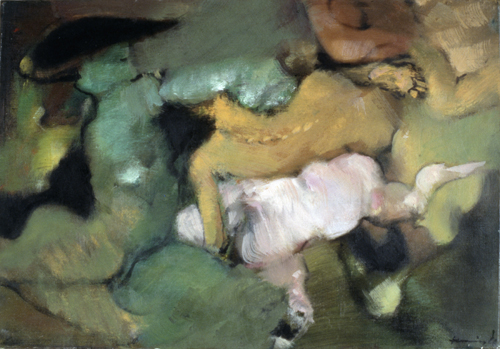Dorothea Tanning was a painter, printmaker, sculptor, set designer, writer and poet who died last year at the age of 101. Best known for her enigmatic works of the 1940s and 1950s, which feature women and girls involved with strange animals and animated swaths of cloth or shreds of wallpaper, Tanning created a forceful combination of erotic danger and allure.
Birthday (1942) is a portrait of the artist as a young bacchante. Standing, bare-breasted, in a skirt composed of roots and tresses of hair before a succession of receding doorways, she is accompanied by a familiar winged quadruped, much like the comical demons that tormented Bosch’s saints. Eine Kleine Nachtmusik (A Little Night Music) (1943) features two young girls in tattered garments, clutching parts of a gigantic sunflower, fallen to the floor yet still alive; a series of closed doors gives way to one that is slightly ajar, admitting a wedge of yellow light. One girl listens, eyes closed, at one of the doors. The other, her face turned from us, regards the flower, while her long hair ripples upward, like tendrils or flames.
Tanning is also known as the wife of Dadaist/Surrealist Max Ernst. The personal and creative partnership lasted 30 years, though Tanning’s work was eclipsed in popularity by her older, more famous husband’s. When Ernst died in 1976, Tanning returned from France to New York, where she continued working for another 25 years, focusing, after a stroke, on the poetry and writing that would give her a late second creative career and further renown. Of the 30 works—oil paintings, sculptures, and drawing—included in “Unknown But Knowable States,” many have not been widely seen.
Tanning, whose tolerance for formal education had limits, was to an extent self-taught. A push-pull between attraction and repulsion powers the abstract images of tangled, submerged female figures, flying or falling that evolved in her “prism” or “insomnia” paintings from the mid-1950s. In Eclipse (1966) and Salut, Délire! (Hail, Delirium!) (1979), the traditional figurative art of Tiepolo, Rubens, Watteau and Rodin is reinterpreted through a combination of Cubist planes, Futurist simultaneity, Surrealist metamorphosis and Abstract Expressionist all-over patterning. This improbably successful eclectic mix is additionally leavened with Tanning’s semi-abstract eroticism—see Untitled (1965), with its echoes of Léonor Fini and Balthus and Notes for an Apocalypse (1978)—as well as her perversely humorous Peke-a-poo canine companions.
In Faith, Surrounded by Hope, Charity, and Other Monsters (1976), there’s an unmistakable similarity to Ernst’s grattage paintings of the same period, but Tanning’s vision is darker—more romantic and dramatic. A couple of sculptures, Traffic Sign (1970) and Etreinte (Restraint or Grip) (1969), exploit the abject faux coziness of fake fur. There’s an unusual note of pathos in Tanning’s drawing, Birthday, made in August, 1976, four months after her husband’s death; a woman, stunned, lies on a huge bed, almost buried herself, beneath a darkened sky.


